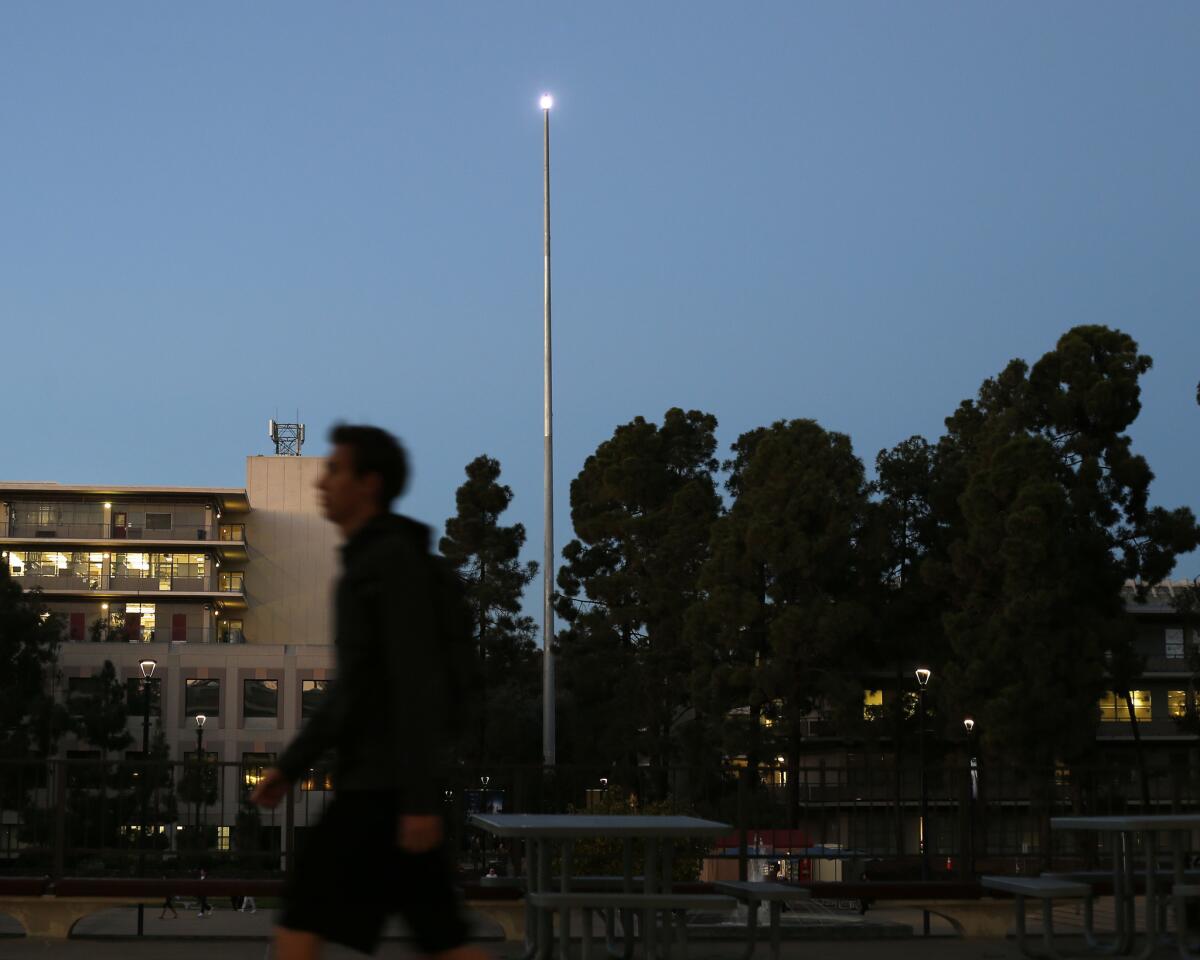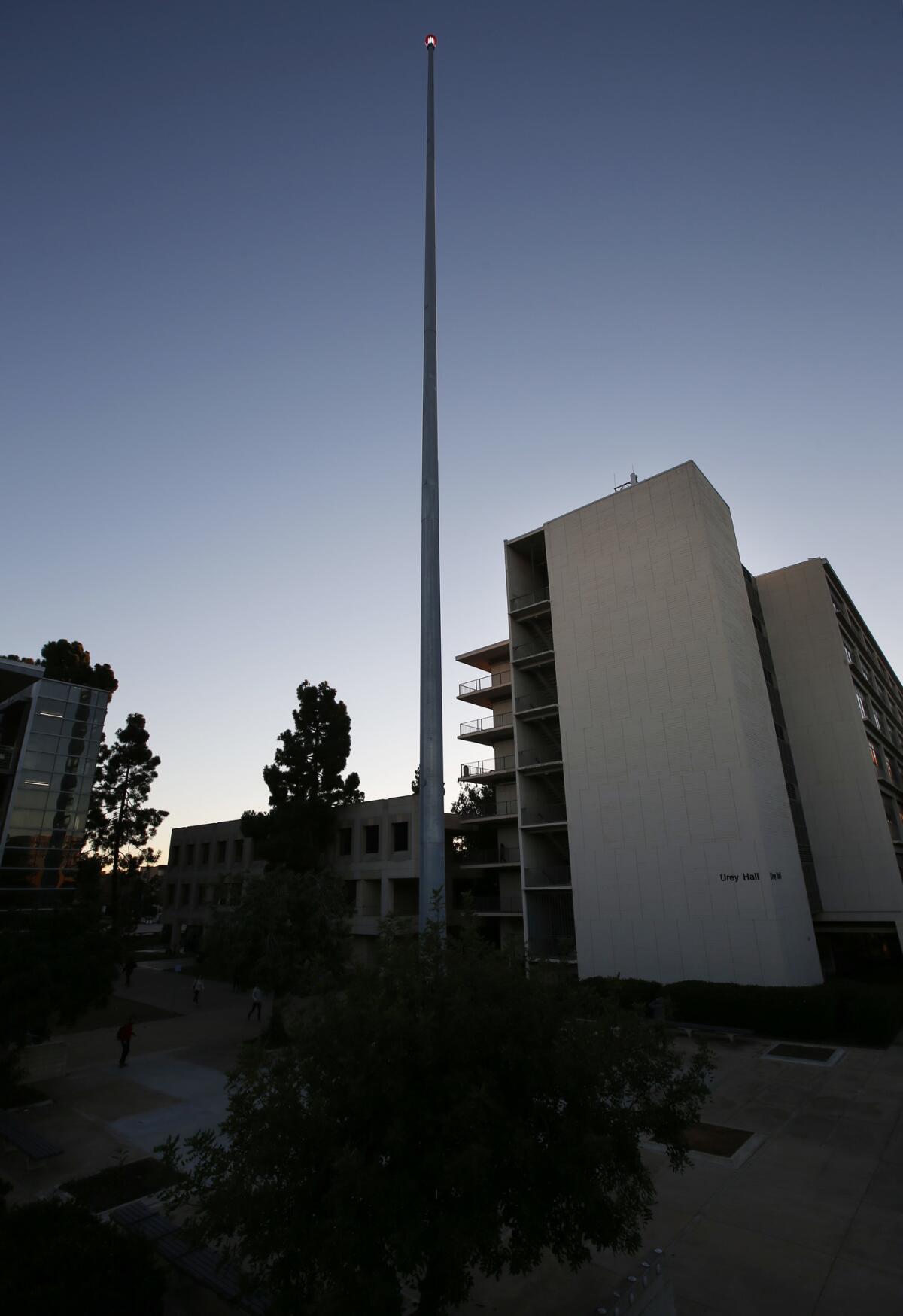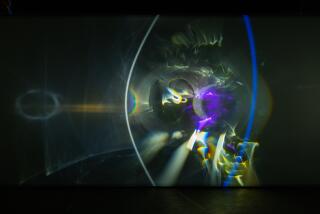Mark Bradford’s new sculpture is visible from I-5. (Hint: It blinks)

- Share via
Reporting from San Diego — Mark Bradford’s newly installed sculpture at UC San Diego can be seen for miles — from cars on Interstate 5 and the streets of La Jolla, from dorm rooms on campus as well as from the chancellor’s house, where confused dinner guests have asked, just what is that blinking light?
The question endures for all who see it, even after the light source is identified as the 20th work in the university’s Stuart Collection of site-specific art. Erected in October and dedicated this month, Bradford’s piece is a 196-foot galvanized steel pole topped with a 4-foot LED, flashing day and night.
Is it a beacon? Or a warning?
The blinking lights spell out in Morse code the work’s title, “What Hath God Wrought,” the first words sent over the nation’s initial stretch of telegraph line in 1844. The phrase derives from the Book of Numbers, where it serves as a vaguely celebratory exclamation. When used today, the inference is typically bleak.
For Bradford, the meaning of the signal has shifted over time. He conceived of the piece in 2014 as a prompt to ponder the global, dematerialized communication network launched by Samuel B. Morse’s momentous act, to contribute to “the whole conversation about privacy and censorship, and who gets to be in charge of information.” Rising several years later, smack in the middle of the Trump presidency, the piece embodies a new sort of disquiet for the artist. It’s “a cry of rage,” he said.
“When I look at it now, it pulsates with a sense of emergency,” he adds.” It says, ‘Help us.’ It feels more like an SOS.”

No, honey. This isn’t the airport.
— Artist Mark Bradford, answering a question on whether the light on his new sculpture would change over time.
Mary Beebe, director of the Stuart Collection, reached out to Bradford in 1995, but he wasn’t interested then in making a permanent public work. He was in the middle of his studies at the California Institute of the Arts, where he earned bachelor’s and master’s degrees. The L.A. native has since achieved international attention for his layered, rigorously carved and sanded collage paintings, made first with end papers from his mother’s hair salon and subsequently with advertising posters from the street.
In 2009, he was named a MacArthur fellow. In 2013, when he finally accepted Beebe’s invitation, he was at work on a permanent installation for the Tom Bradley International Terminal at LAX that he completed in 2015. Around the same time, he co-founded Art + Practice, a foundation in Leimert Park offering exhibitions, public programs and social services, particularly to foster youth. Last year, he represented the United States at the Venice Biennale.
“What Hath God Wrought” takes note of one beginning and is located on the spot of another. A plaque at the base of the pole commemorates the site where UC San Diego was dedicated in 1961. Nearby is an oak tree planted by the Revelle College charter freshman class in 1964, a flagpole (which suddenly resembles a toothpick in relation to Bradford’s piece) dedicated by college Republicans in 1967, and a bench in honor of student activists of 1970. The new sculpture takes its place among these memorials and inserts itself into the current dialogue around historical figures and monuments.
Regarding what Morse hath wrought, Bradford said, “I’m asking us, is this heroic?”
Like many pieces in the Stuart Collection — including works by Bruce Nauman, Alexis Smith, Do Ho Suh, Robert Irwin, Kiki Smith and Jenny Holzer — “What Hath God Wrought” is well-integrated into the campus but also something of a physical and psychic disruption. The conspicuous girth of the pole at ground level (about 3 feet in diameter), the extremity of its height (as high as it could go per FAA regulations), the intensity of the blinking light and the message it spells are all insistent and inescapable.
On the night the piece was dedicated, a woman attending Bradford’s presentation asked whether the flashing message would change. “No, honey,” Bradford shot back. “This isn’t the airport.” A young man, ostensibly a student housed close enough to be bothered by the light, suggested he turn down the brightness. Earlier in the vetting process, a professor took issue with the use of the word God.
None of the pushback surprised or troubled Beebe. Objections have been raised since the installation of the collection’s first piece, Niki de Saint Phalle’s “Sun God” (1983), which is now a beloved campus landmark.
“You always think about repercussions,” she said by phone the morning after the dedication, “but we’re not timid, the Stuart Collection, or we wouldn’t do anything. People adjust. We’re not decorating the campus, we’re providing experiences that people can engage or not. The Bradford is a bit in your face, but he wanted it to have that urgency.”
MORE ART:
John Luther Adams’ addition to UCSD’s Stuart Collection
Do Ho Suh’s ‘Fallen Star’ is nauseating — in a good way
Best art 2018: Times critic Christopher Knight’s list
See all of our latest arts news and reviews at latimes.com/arts.
More to Read
The biggest entertainment stories
Get our big stories about Hollywood, film, television, music, arts, culture and more right in your inbox as soon as they publish.
You may occasionally receive promotional content from the Los Angeles Times.










